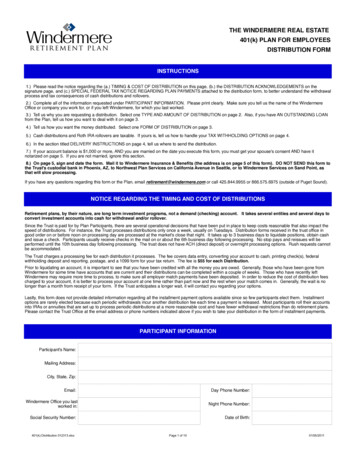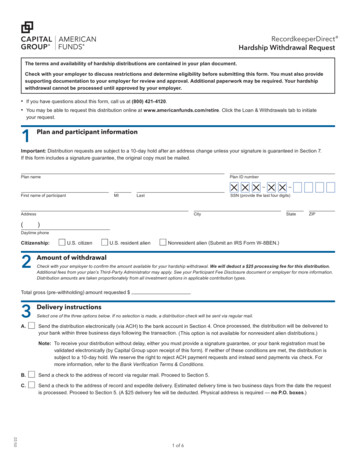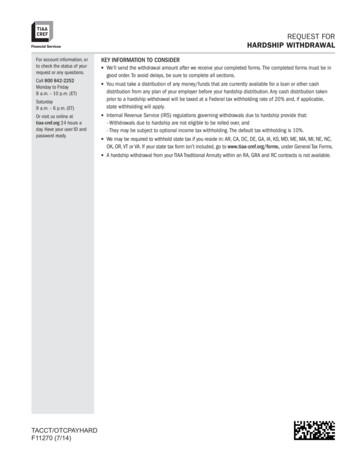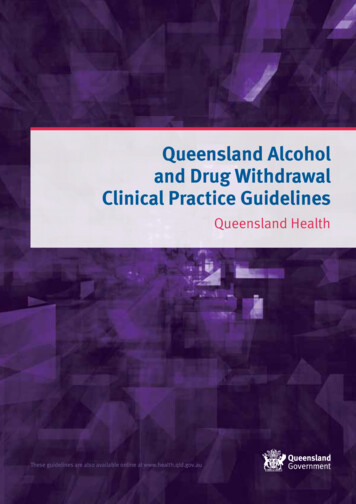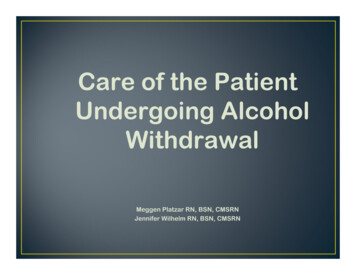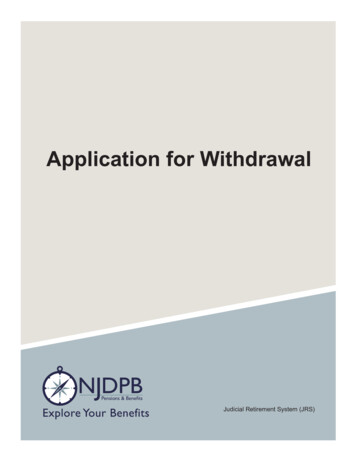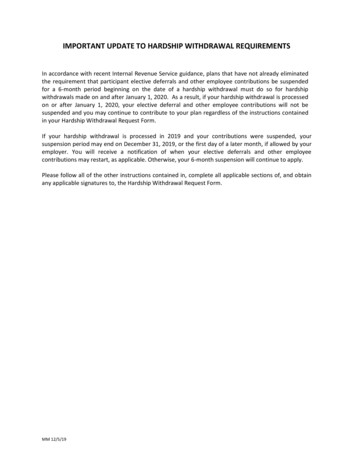
Transcription
IMPORTANT UPDATE TO HARDSHIP WITHDRAWAL REQUIREMENTSIn accordance with recent Internal Revenue Service guidance, plans that have not already eliminatedthe requirement that participant elective deferrals and other employee contributions be suspendedfor a 6-month period beginning on the date of a hardship withdrawal must do so for hardshipwithdrawals made on and after January 1, 2020. As a result, if your hardship withdrawal is processedon or after January 1, 2020, your elective deferral and other employee contributions will not besuspended and you may continue to contribute to your plan regardless of the instructions containedin your Hardship Withdrawal Request Form.If your hardship withdrawal is processed in 2019 and your contributions were suspended, yoursuspension period may end on December 31, 2019, or the first day of a later month, if allowed by youremployer. You will receive a notification of when your elective deferrals and other employeecontributions may restart, as applicable. Otherwise, your 6-month suspension will continue to apply.Please follow all of the other instructions contained in, complete all applicable sections of, and obtainany applicable signatures to, the Hardship Withdrawal Request Form.MM 12/5/19
Hardship Withdrawal FormINSTRUCTIONS AND INFORMATION FOR COMPLETING THIS FORMPlease note: A signature guarantee is required for distributions of 150,000 or more.)Please note: A signature guarantee is required for distributions of 150,000 or more.)HARDSHIP WITHDRAWAL GUIDELINESDecember 2019Page 1 of 162938 Hardship Withdrawal Request - ISC SEP
SECTION A. Plan InformationCompany/Employer NameCentral California Child Development Service, Inc.Plan NameContract NumberCCCDS Retirement Savings PlanDivision Number (if applicable)601447SECTION B. Participant Information — Please printSocial Security No.– –Date of Birth (mmddyyyy)– –Date of Hire (mmddyyyy)– –Last NameE-mail AddressFirst Name/Middle InitialStreet Address/Apt. No.CityPhone No.( )–StateZip CodeExt. (if any)Marital StatusMarriedUnmarriedMAIL DELIVERYIf no address is provided in Section B, the address on file will be used to process this request. All checks will be sent via First Class Mailunless the Overnight Mail box is checked below.Send check overnight mail and deduct 40.00 from the check for express charges. Please note: A street address must be provided.SECTION C. Hardship ReasonMy hardship withdrawal request is for the purpose of meeting the financial need(s) indicated below:Purchase of a Principal Residence (excluding mortgage payments; must provide a signed contract by buyer and seller to yourEmployer)College/Post-Secondary Tuition (provide tuition bill for period within the next 12 months for self, spouse, dependents orbeneficiary(s) to your Employer)Medical Expenses (must provide unreimbursed medical bill indicating insurance portion or denial letter from insurance carrier for self,spouse, dependents or beneficiary(s) to your Employer)Foreclosure/Eviction - Principal Residence (must provide foreclosure or eviction notice to your Employer)Funeral or Burial Expenses (provide a bill for funeral or burial expenses for your parent, spouse, child, dependent or beneficiary(s)to your Employer)Damage to Principal Residence (provide a bill for expenses to repair your principal residence, along with a statement certifying thatthe damage qualifies for a casualty loss deduction under Code Section 165 to your Employer)I have provided supporting documentation as indicated below:Type of HardshipDecember 2019Type of DocumentationDatePage 2 of 162938 Hardship Withdrawal Request - ISC SEP
SECTION D. Hardship AmountThe amount of money I will need to satisfy this hardship is Allowed" under your plan).(an amount must be specified, or the "MaximumNote: Your payout will automatically be prorated against all investment options. You may increase your hardship amount to includethe taxes that would be withheld if elected.SECTION E. Income Tax WithholdingFailure to provide your correct taxpayer identification number will result in mandatory withholding of income tax.FEDERAL INCOME TAXA 10% federal income tax withholding will apply to all taxable distributions unless you elect otherwise.Do not withhold federal income tax from my distribution.STATE INCOME TAXIf your address of record is within a mandatory withholding state, state taxes will be withheld from your distribution in accordance with therespective state rules. Other states allow an independent election and in these states, state tax will be withheld unless you electotherwise. If your state does not allow withholding, no state tax can be withheld. Please contact Transamerica to confirm if your state has amandatory state tax.Do not withhold state income tax (ONLY IF INDEPENDENT ELECTION IS PERMITTED).Withhold state income tax: % (If your state requires a greater withholding percentage than what you have indicated, themandatory state tax will apply).SECTION F. Spousal ConsentCheck with your Employer/Plan Administrator or your Summary Plan Description to determine whether this plan is subject to spousal consentrequirements. If spousal consent is required, complete this section. Otherwise skip to Section G.You must have your spouse’s signature notarized or have a plan representative witness your spouse’s signature if your vested accountbalance is greater than 5,000. However, if the vested account balance is less than 5,000 spousal consent is not required.Spousal ConsentI, the undersigned spouse of the participant, understand that federal law requires that I consent in writing to any distribution from the planunless that distribution is in the form of a joint and survivor annuity. I have read the IRS Special Tax Notice provided to me and hereby waivemy rights to have the amount of the hardship distribution payable in an annuity. I understand the effects of this waiver and consent to thehardship distribution elected by my spouse.Signature of Participant’s Spouse:Date:Statement of Plan Representative or Notary PublicThe spouse whose signature I have witnessed is known to me and signed this form in my presence.Plan Representative:Date:Notary Public Signature:Date:PLACE SEAL HERE (if applicable)December 2019Page 3 of 162938 Hardship Withdrawal Request - ISC SEP
SECTION G. Participant SignatureSignature Guarantee – Place Medallion Stamp Below (Required if distribution is 150,000 or more.)A request for a withdrawal of 150,000 or more requires that this completed form be stamped with a medallion signature guarantee. You can obtaina medallion signature guarantee from a financial institution such as a commercial bank, savings bank, credit union, or broker-dealer. A notary isNOT a medallion signature guarantee.The original form, stamped with the medallion signature guarantee, must be presented to your Plan Administrator for approval.Please note, for this purpose, the value of the withdrawal is based on the amount available (for full distributions and rollovers) on the date ofprocessing and multiple withdrawal requests within a 14-day period that total 150,000 or more will be subject to the medallion signature guaranteerequirements.Participant’s Distribution is 150,000 or moreMedallion Signature Guarantee – Place Medallion Stamp BelowPARTICIPANT SIGNATUREThe above information and any substantiating documentation is true and correct to the best of my knowledge. I understand andagree that Transamerica Retirement Solutions, LLC, its parents, affiliates,subsidiaries, related companies, employees, agents, officersand directors (a) are not responsible for determining whether my request satisfies applicable tax or other legal requirements, and (b)have no liability to me or any other person for any adverseconsequences resulting from payment of my hardship withdrawal as requested. I understand that a copy of this form must besubmitted to my employer/plan administrator. In addition, I acknowledge that I have received the “Special Tax Notice RegardingPayments From Qualified Plans.”My signature acknowledges that the required documentation will be submitted with this form for approval by the Plan Sponsor. In addition,I acknowledge that I have read, understand and agree to all the terms of this Distribution Request form, and affirm that all informationthat I have provided is true and correct. Further, I acknowledge that I have received the “Special Tax Notice Regarding Payments FromQualified Plans” and other required notices. The above information is true and correct to the best of my knowledge. I further understandthat I may revoke this election at any time prior to the distribution taking place.As part of my request for the above financial hardship, I certify that: (1) I have insufficient cash or other assets available for liquidationto satisfy the immediate and heavy financial need that exists on account of this hardship and that borrowing from a commercial sourceto satisfy the need would be counterproductive and would increase the amount of the need; (2) I have obtained all distributions currentlyavailable under all of my employer’s plans; and (3) upon request of the Plan Administrator, I will provide independent written evidenceof my financial hardship amount.CDateSignature of ParticipantMUST BE COMPLETED BY THE PLAN ADMINISTRATOR, TRUSTEE OR AUTHORIZED SIGNER ONLYBy signing below, I hereby authorize Transamerica to process the distribution described in this form. This request is incompliance with plan provisions.If spousal consent is not provided, then in accordance with the terms and provisions of the plan and under the current law,spousal consent is not required for payment of the requested benefit.CCBy: Signature of Plan Administrator, Trustee or Authorized SignerDatePrint Name of Plan Administrator, Trustee or Authorized SignerDateA photocopy of this form and any supporting documentation should be kept for your records and maintained according togovernment auditing standards.Once this form has been completed with all of the necessary information and required signatures, please forward to the ProcessingCenter for processing. This form cannot be processed without the Plan Administrator, Trustee or Authorized Signer’s signature.FOR PLAN ADMINISTRATOR USE ONLY - MAIL TO: Processing Center: 6400 C Street SW, Cedar Rapids, IA 52499, Fax: 833-200-9987December 2019Page 4 of 162938 Hardship Withdrawal Request - ISC SEP
ddWWd/W/hdd/ddE/E///:dhW//EWWDecember 2019/W:/WPage 5 of 162938 Hardship Withdrawal Request - ISC SEP
dddh/Y:WW// d////WWWW/WW/tDecember 2019Page 6 of 16W2938 Hardship Withdrawal Request - ISC SEP
Special Tax Notice Regarding Plan Payments(Including Payments From Your Designated Roth Account, If Applicable)YOUR ROLLOVER OPTIONSYou are receiving this notice because all or a portion of a payment you are receiving from your employer’s retirement plan is eligible to be rolledover to a Traditional IRA, a Roth IRA or an employer plan. This notice is intended to help you decide whether to do such a rollover.Section I of this notice describes the rollover rules that apply to payments from the Plan that are not from a designated Roth account (a typeof account with special tax rules in some employer plans).Section II applies if you also receive a payment from a designated Roth account in the Plan, in which case the plan administrator or the payor will tellyou the amount that is being paid from each account.Rules that apply to most payments from a plan are described in the “General Information About Rollovers” section. Special rules that only apply incertain circumstances are described in the “Special Rules and Options” section.Generally, neither a direct rollover nor a payment can be made from the Plan until at least 30 days after your receipt of this notice. Thus, afterreceiving this notice, you have at least 30 days to consider whether or not to have your withdrawal directly rolled over. If you do not wish to waituntil this 30-day notice period ends before your election is processed, you may waive the notice period by making an affirmative electionindicating whether or not you wish to make a direct rollover. Your withdrawal will then be processed in accordance with your election as soon aspractical after it is received by the Plan Administrator.Section I: GENERAL INFORMATION ABOUT ROLLOVERS FROM YOUR RETIREMENT PLAN (Not Including Any Designated Roth Account)How can a rollover affect my taxes?You will generally be taxed on a payment from the Plan if you do not roll it over. However, rollovers to a designated Roth account within the Planor to a Roth IRA that are not from a designated Roth account are subject to taxation, as discussed below. If you are under age 59½ and do not doa rollover, you will also have to pay a 10% additional income tax on early distributions (generally, distributions made before age 59½), unless anexception applies. However, if you do a rollover, you will not have to pay tax until you receive payments later and the 10% additional income taxwill not apply if those payments are made after you are age 59 1/2 (or if an exception applies).What types of retirement accounts and plans may accept my rollover?You may roll over the payment to either an IRA (an individual retirement account or individual retirement annuity) or an employer plan (a taxqualified plan, section 403(b) plan, or governmental section 457(b) plan) that will accept the rollover. The rules of the IRA or employer plan thatholds the rollover will determine your investment options, fees, and rights to payment from the IRA or employer plan (for example, no spousalconsent rules apply to IRAs and IRAs may not provide loans). Further, the amount rolled over will become subject to the tax rules that apply to theIRA or employer plan.You may also roll over the payment to a designated Roth account within the Plan.How do I do a rollover?There are two ways to do a rollover. You can generally do either a direct rollover or a 60-day rollover.If you do a direct rollover, the Plan will make the payment directly to your IRA or an employer plan. You should contact the IRA sponsor or theadministrator of the employer plan for information on how to do a direct rollover.If you do not do a direct rollover, you may still do a rollover by making a deposit into an IRA or eligible employer plan that will accept it. Generally, youwill have 60 days after you receive the payment to make the deposit. If you do not do a direct rollover, the Plan is required to withhold 20% of thepayment for federal income taxes (up to the amount of cash and property received other than employer stock). This means that, in order to roll overthe entire payment in a 60-day rollover, you must use other funds to make up for the 20% withheld. If you do not roll over the entire amount of thepayment, the portion not rolled over will be taxed and will be subject to the 10% additional income tax on early distributions if you are under age 591/2 (unless an exception applies).How much may I roll over?If you wish to do a rollover, you may roll over all or part of the amount eligible for rollover. Any payment from the Plan is eligible for rollover, except: Certain payments spread over a period of at least 10 years or over your life or life expectancy (or the lives or joint life expectancy ofyou and your beneficiary); Required minimum distributions after age 70 1/2 (or after death); Hardship distributions; ESOP dividends; Corrective distributions of contributions that exceed tax law limitations; Loans treated as deemed distributions (for example, loans in default due to missed payments before your employment ends) Cost of life insurance paid by the Plan; Payments of certain automatic enrollment contributions requested to be withdrawn within 90 days of the first contribution; and Amounts treated as distributed because of a prohibited allocation of S corporation stock under an ESOP (also, there will generally beadverse tax consequences if you roll over a distribution of S corporation stock to an IRA).The plan administrator or the payor can tell you what portion of a payment is eligible for rollover.2768-TRS (rev 11/18) (Page 1 of 8)December 2019Page 7 of 162938 Hardship Withdrawal Request - ISC SEP
If I don’t do a rollover, will I have to pay the 10% additional income tax on early distributions?If you are under age 59 1/2, you will have to pay the 10% additional income tax on early distributions for any payment from the Plan (includingamounts withheld for income tax) that you do not roll over, unless one of the exceptions listed below applies. This tax applies to the part ofthe distribution that you must include in income and is in addition to the regular income tax on the payment not rolled over.The 10% additional income tax does not apply to the following payments from the Plan: Payments made after you separate from service if you will be at least age 55 in the year of the separation; Payments that start after you separate from service if paid at least annually in equal or close to equal amounts over your life or lifeexpectancy (or the lives or joint life expectancy of you and your beneficiary); Payments from a governmental plan made after you separate from service if you are a qualified public safety employee and you will be atleast age 50 in the year of the separation; Payments made due to disability; Payments after your death; Payments of ESOP dividends; Corrective distributions of contributions that exceed tax law limitations; Cost of life insurance paid by the Plan; Payments made directly to the government to satisfy a federal tax levy; Payments made under a qualified domestic relations order (QDRO); Payments up to the amount of your deductible medical expenses (without regard to whether you itemize deductions for the taxable year); Certain payments made while you are on active duty if you were a member of a reserve component called to duty after September 11, 2001for more than 179 days; Payments of certain automatic enrollment contributions requested to be withdrawn within 90 days of the first contribution; Payments for certain distributions relating to certain federally declared disasters; and Phased retirement payments made to federal employees.If I do a rollover to an IRA, will the 10% additional income tax apply to early distributions from the IRA?If you receive a payment from an IRA when you are under age 59½, you will have to pay the 10% additional income tax on early distributions on thepart of the distribution that you must include in income, unless an exception applies. In general, the exceptions to the 10% additional income tax forearly distributions from an IRA are the same as the exceptions listed above for early distributions from a plan. However, there are a few differencesfor payments from an IRA, including: The exception for payments made after you separate from service if you will be at least age 55 in the year of the separation (or age 50 forqualified public safety employees) does not apply. The exception for qualified domestic relations orders (QDROs) does not apply (although a special rule applies under which, as part of adivorce or separation agreement, a tax-free transfer may be made directly to an IRA of a spouse or former spouse). The exception for payments made at least annually in equal or close to equal amounts over a specified period applies without regard towhether you have had a separation from service. There are additional exceptions for (1) payments for qualified higher education expenses, (2) payments up to 10,000 used in a qualifiedfirst-time home purchase, and (3) payments for health insurance premiums after you have received unemployment compensation for 12consecutive weeks (or would have been eligible to receive unemployment compensation but for self-employed status.)Will I owe State income taxes?This notice does not describe any State or local income tax rules (including withholding rules).SPECIAL RULES AND OPTIONS For Payments From Your Retirement Account (Not Including Your Designated Roth Account)If your payment includes after-tax contributions:After-tax contributions included in a payment are not taxed. If a payment is only part of your benefit, an allocable portion of your after-taxcontributions is included in the payment, so you cannot take a payment of only after-tax contributions. However, if you have pre-1987 after-taxcontributions maintained in a separate account, a special rule may apply to determine whether the after-tax contributions are included in a payment.In addition, special rules apply when you do a rollover, as described below.You may roll over to an IRA a payment that includes after-tax contributions through either a direct rollover or a 60-day rollover. You must keep trackof the aggregate amount of the after-tax contributions in all of your IRAs (in order to determine your taxable income for later payments from theIRAs). If you do a direct rollover of only a portion of the amount paid from the Plan and at the same time the rest is paid by you, the portion directlyrolled over consists first of the amount that would be taxable if not rolled over. For example, assume you are receiving a distribution of 12,000, of which 2,000 is after-tax contributions. In this case, if you directly roll over 10,000 to an IRA that is not a Roth IRA, no amount is taxablebecause the 2,000 amount not directly rolled over is treated as being after-tax contributions. If you do a direct rollover of the entire amount paidfrom the Plan to two or more destinations at the same time, you can choose which destination receives the after-tax contributions.2768-TRS (rev 11/18) (Page 2 of 8)December 2019Page 8 of 162938 Hardship Withdrawal Request - ISC SEP
If you do a 60-day rollover to an IRA of only a portion of a payment made to you, the after-tax contributions are treated as rolled over last. Forexample, assume you are receiving a distribution of 12,000, of which 2,000 is after-tax contributions, and no part of the distribution is directlyrolled over. In this case, if you roll over 10,000 to an IRA that is not a Roth IRA in a 60 day rollover, no amount is taxable because the 2,000 amountnot rolled over is treated as being after-tax contributions.You may roll over to an employer plan all of a payment that includes after-tax contributions, but only through a direct rollover (and only if the receivingplan separately accounts for after-tax contributions and is not a governmental section 457(b) plan). You can do a 60-day rollover to an employer plan ofpart of a payment that includes after-tax contributions, but only up to the amount of the payment that would be taxable if not rolled over.If you miss the 60-day rollover deadline:Generally, the 60-day rollover deadline cannot be extended. However, the IRS has the limited authority to waive the deadline under certainextraordinary circumstances, such as when external events prevented you from completing the rollover by the 60-day rollover deadline. Undercertain circumstances, you may claim eligibility for a waiver of the 60-day rollover deadline by making a written self-certification. Otherwise, toapply for a waiver from the IRS, you must file a private letter ruling request with the IRS. Private letter ruling requests require the payment of anonrefundable user fee. For more information, see IRS Publication 590-A, Contributions to Individual Retirement Arrangements (IRAs).If your payment includes employer stock that you do not roll over:If you do not do a rollover, you can apply a special rule to payments of employer stock (or other employer securities) that are either attributable toafter-tax contributions or paid in a lump sum after separation from service (or after age 59 1/2, disability, or the participant’s death). Under thespecial rule, the net unrealized appreciation on the stock will not be taxed when distributed from the plan and will be taxed at capital gain rateswhen you sell the stock. Net unrealized appreciation is generally the increase in the value of employer stock after it was acquired by the plan. If youdo a rollover for a payment that includes employer stock (for example, by selling the stock and rolling over the proceeds within 60 days of thepayment), the special rule relating to the distributed employer stock will not apply to any subsequent payments from the IRA or employer plan. Theplan administrator can tell you the amount of any net unrealized appreciation.If you have an outstanding loan that is being offset:If you have an outstanding loan from the Plan, your Plan benefit may be offset by the outstanding amount of the loan, typically when youremployment ends. The offset amount is treated as a distribution to you at the time of the offset. Generally, you may roll over all or any portion ofthe offset amount. Any offset amount that is not rolled over will be taxed (including the 10% additional income tax on early distributions, unless anexception applies). You may roll over offset amounts to an IRA or an employer plan (if the terms of the employer plan permit the plan to receiveplan loan offset rollovers).How long you have to complete the rollover depends on what kind of plan loan offset you have. If you have a qualified plan loan offset, you will haveuntil your tax return due date (including extensions) for the tax year during which the offset occurs to complete your rollover. A qualified plan loanoffset occurs when a plan loan in good standing is offset because your employer plan terminates, or because you sever from employment. If your planloan offset occurs for any other reason, then you have 60 days from the date the offset occurs to complete your rollover.If you were born on or before January 1, 1936:If you were born on or before January 1, 1936 and receive a lump sum distribution that you do not roll over, special rules for calculating theamount of the tax on the payment might apply to you. For more information, see IRS Publication 575, Pension and Annuity Income.If your payment is from a governmental section 457(b) plan:If the plan is a governmental section 457(b) plan, the same rules described elsewhere in this notice generally apply, allowing you to roll over thepayment to an IRA or an employer plan that accepts rollovers. One difference is that, if you do not do a rollover, you will not have to pay the 10%additional income tax on early distributions from the plan even if you are under age 59 1/2 (unless the payment is from a separate accountholding rollover contributions that were made to the Plan from a tax-qualified plan, a section 403(b) plan, or an IRA). However, if you do arollover to an IRA or to an employer plan that is not a governmental section 457(b) plan, a later distribution made before age 59 1/2 will besubject to the 10% additional income tax on early distributions (unless an exception applies). Other differences include that you cannot do arollover if the payment is due to an “unforeseeable emergency” and the special rules under “If your payment includes employer stock that youdo not roll over” and “If you were born on or before January 1, 1936” do not apply.If you are an eligible retired public safety officer and your payment is used to pay for health coverage or qualified long-term careinsurance:If the Plan is a governmental plan, you retired as a public safety officer, and your retirement was by reason of disability or was after normalretirement age, you can exclude from your taxable income Plan payments paid directly as premiums to an accident or health plan (or a qualifiedlong-term care insurance contract) that your employer maintains for you, your spouse, or your dependents, up to a maximum of 3,000 annually.For this purpose, a public safety officer is a law enforcement officer, firefighter, chaplain, or member of a rescue squad or ambulance crew.If you roll over your payment to a Roth IRA:If you roll over a payment from the Plan to a Roth IRA, a special rule applies under which the amount of the payment rolled over (reduced by anyafter-tax amounts) will be taxed. However, the 10% additional income tax on early distributions will not apply (unless you take the amount rolledover out of the Roth IRA within 5 years, counting from January 1 of the year of the rollover).2768-TRS (rev 11/18) (Page 3 of 8)December 2019Page 9 of 162938 Hardship Withdrawal Request - ISC SEP
If you roll over the payment to a Roth IRA, later payments from the Roth IRA that are qualified distributions will not be taxed (including earningsafter the rollover). A qualified distribution from a Roth IRA is a payment made after you are age 59 1/2 (or after your death or disability, or as aqualified first-time home buyer distribution of up to 10,000) and after you have had a Roth IRA for at least 5 years. In applying this 5-year rule,you count from January 1 of the year for which your first contribution was made to a Roth IRA. Payments from the Roth IRA that are not qualifieddistributions will be taxed to the extent of earnings after the rollover, including the 10% additional income tax on early distributions (unless anexception applies). You do not have to take required minimum distributions from a Roth IRA during your lifetime. For more information, see IRSPublication 590, Individual Retirement Arrangements (IRAs)You may roll over a payment from the Plan to a designated Roth account within the Plan.If you do a roll over to a designated Roth account in the Plan:You cannot roll over a distribution to a designated Roth account in another employer’s plan. However, you can roll the distribution over into adesignated Roth account in the distributing Plan. If you roll over a payment from the Plan to a designated Roth account in the Plan, the amount ofthe payment rolled over (reduced by any after-tax amounts directly rolled over) will be taxed. However, the 10% additional tax on earlydistributions will not apply (un
Please note, for this purpose, the value of the withdrawal is based on the amount available (for full distributions and rollovers) on the date of processing and multiple withdrawal requests within a 14-day period that total 150,000 or more will be subject to the medallion signature guarantee requirements. CSignature of Participant Date
